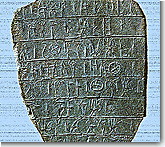




    |
|
|
|
The greatest cultural achievement of Archaic times was undoubtedly the adoption of the Phoenician script by the Hellenes and its application to the phonetic needs of the Greek language. The view is prevalent today that the knowledge of writing vanished with the end of the Mycenaean world. Linear B, which was mostly used by specialist palace scribes to draw up census records, never, because of its complexity, gained wide currency. However high we set the upper limit for the adoption of the Phoenician script, present evidence indicates that for some centuries writing was a forgotten thing in Greece. Once knowledge of writing was regained, the uses for it multiplied compared with the Mycenaean age. |  |
The innovation which the Hellenes brought in and defined the evolution of the Greek language and of all other European languages lies in the use of letters to represent vowel sounds. The North-Semitic alphabet contained twenty-two symbols to indicate the consonants and the semi-vowels. Some of these sounds were unknown to the Greek system of phonology and were probably perceived by the Hellenes more as vowels than as glottal stops. As a result, aleph was used for á, he for å, yod for é, waw for õ, and ayin for ï. |
 |  | From the very first years of the use of the alphabet, many differences can be seen from region to region. Certain basic letters of the Phoenician prototype do not always retain the same phonetic value. Moreover, the Hellenic additions of characters, selected or introduced on account of the need for the aspirated consonants ö and ÷, and for the double consonants ø, î, and æ to be represented, were not everywhere identical. Also variable were the forms of script that developed; as were the choices of character to indicate aspirated vowels and to differentiate the long from the short. The process of employing and enriching the alphabet, completed by the introduction of ù, seems to have been achieved by the start of the 7th century B.C. However, its homogenization and the dominance of the most developed and fullest model of the alphabet, that of Ionia, lasted for many centuries and only took its real substance after its institution in Athens in 403-2 B.C., in the archonship of Euclides. The writing of numbers was only just homogenized in Hellenistic times. |
Many criteria have been proposed for the classification of local scripts on the basis of the presence, absence, or selection of certain characters to express a given sound. But none of the resulting systems provides a completely convincing answer. A strong differencing can be detected as between the alphabets of Chalcis and Athens. From the former, the Latin script will emerge; while the second will have its place taken by the Ionic alphabet, to subsequently become the common script of all Hellenes, the one which, with no serious modifications, has survived to the present day. |
|
| |
|
Note: Click on a picture for a brief description. | |